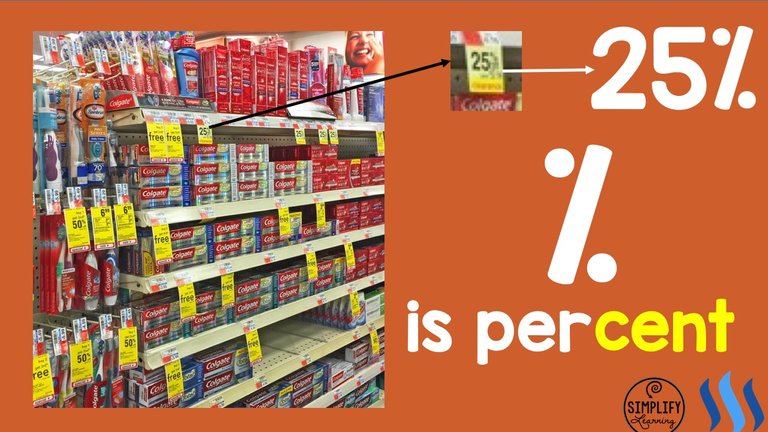This lesson is an application of the strategies from the book, English Learners in the Mathematics Classroom, 2nd Ed. by Debra S. Coggins. I was part of a study group where we discussed this book, chapter by chapter and the following strategies may work on teaching the concept of percent.

Grade: 6th Grade
Math Objective: Students will be able to understand the concept of Percent.
Common Core Standard: CCSS.Math.6.RPA.3C
Find a percent of a quantity as a rate per 100 (e.g., 30% of a quantity means 30/100 times the quantity); solve problems involving finding the whole, given a part and the percent.
Language Objective:
Recognize, write and comprehend Percent and its various formats.
Introduction Using Conversational Language

Using the picture above (taken at a local drugstore), start a conversation on what the students see. Lead them to the symbols for dollars and percent. Ask about money in their country where they come from. Then ask how they learned to use money here.
Easing into Academic Vocabulary using Sentence Structures
Introduce other money concepts by discussing the prices of the items in the pictures. Write the word “cent” and tell them it means 100 in latin. Numbers are somewhat universal. Most English Language Learners can easily understand what 100 means. If not, use a hundred board and let them count by tens or ones.Introduce “per” using sentence structures like you will pay $--- per specific item. For example, you will pay $6.99 per toothbrush. Use other sentence structures. Add vocabulary that will help them bridge what they know.
Sentence structure examples are:
- I will pay $6.99 per toothbrush. That means for each toothbrush.
- I will pay [find out] per toothpaste. That means for each toothpaste.
- I will pay [find out] per mouthwash. That means for each mouthwash.
Other words to introduce are: parts, whole, break, put together and similar words. Use sentence structures and let them repeat it until it is easy to say and comprehend.
Scaffolding and Mixed Ability Grouping
After the introductory activities, you will now know the student levels. Use mixed ability grouping. Make them solve a budgeting problem: given $100, how can they budget it to buy toiletries for 5 people. Break down the tasks so that each person can contribute to the task. Afterwards, they will report on how they “broke” the $100 and explain the “parts” of the budget based on the “whole” budget of $100.
Later, let them fill out a budget worksheet. Introduce the word PERCENT (to be expanded and explained later using advanced organizers). Here are some dry erase graphic organizers with place value charts that can be used in small groups. Let them think how "breaking 100" is the same as PERCENT.
Using Concrete Materials
Use play or actual money and items to actually buy the budgeted items. Because the total amount is $100, you can also use a hundreds board with colored tiles to visualize how much money is budgeted per item.
Visual Learning
Using the Frayer Model, the students will define percent based on what they did in the previous activities. The teacher will start the lesson using colored tiles and the hundred board. For example, if $7 is used for a toothbrush, put 7 tiles on the board and say it is 7 % or 7 percent. Let the students list the characteristics of a percent, what it is and what it is not on the Frayer worksheet. Later, using sentence structures, help them define it.
Basic Questioning and Expanding
Using the Frayer worksheet, start questioning by asking them to tell what they listed those characteristics. Expand questioning by asking why or if they agree/disagree.
Comprehensible Input: Did they really understand?
As you listen to their answers during the questioning portion, reflect on the student answers. Did they understand? Comprehensible Input Theory or Input Hypothesis by Stephen Krashen simply means making sure that students understand what you are teaching or your INPUT. If not, there might be some emotional, cultural or even physical (like hunger and tiredness) reasons. If yes, then take note on what worked and share it with their other teachers.
Follow Me & Support Virtual SPED Co-Teaching Project
If you find this lesson useful, follow me here in Steemit or in Facebook. I am also creating materials to support teachers of students with special needs. You can learn more about my projects at Patreon. Some of my links are affiliate links. That means I get a little of any final sales from that link but you do not pay more than the stated price. This money is used to produce lessons or buy teaching materials.
Simplify Learning.Let's simplify learning and empower teachers, @go2sheila for
Congratulations @go2sheila! You have completed some achievement on Steemit and have been rewarded with new badge(s) :
Click on any badge to view your own Board of Honor on SteemitBoard.
For more information about SteemitBoard, click here
If you no longer want to receive notifications, reply to this comment with the word
STOPExcellent post @go2sheila!!! Congrats for winning1!!!
Thanks @cwbrooch!
I also love the concept of simplified learning! Following! I'm an English teacher so we educators should stick together in this IT steemit world :)
Thank you @steemiteducation!
Congratulations @go2sheila! You have completed some achievement on Steemit and have been rewarded with new badge(s) :
Click on any badge to view your own Board of Honor on SteemitBoard.
For more information about SteemitBoard, click here
If you no longer want to receive notifications, reply to this comment with the word
STOP